NavSource Online: Aircraft Carrier Photo Archive
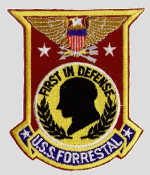
Courtesy of CAPT Gene Oleson, CHC, USN (Ret)
(bluejacket.com)

June 6, 1967
On the afternoon of 6 June 1967 Forrestal got underway to partake in the war in South East Asia. Many of Forrestalís crew do not know what to expect, except some very busy time periods while "on the line", as they call it. Which is the time period that the ship will be operating on Yankee Station off the coast of North Vietnam making air strikes against targets in North Vietnam.
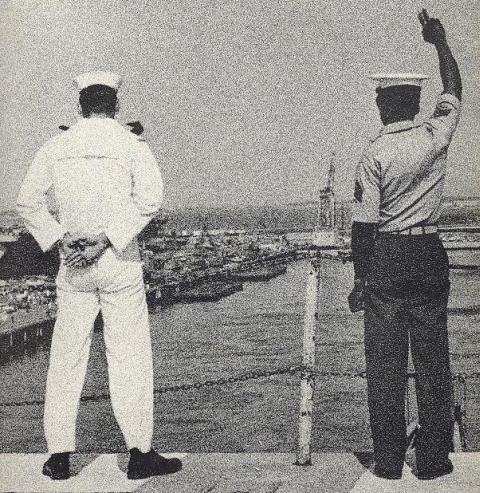 |
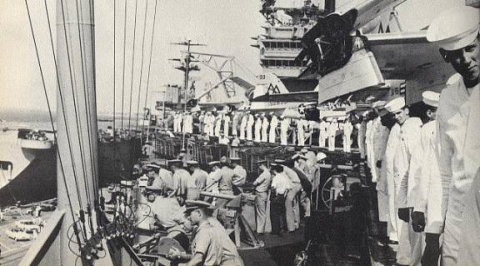 |
| A long Goodbye | |
But, first Forrestal is steaming for some additional training at the Atlantic Fleet Weapons Range and then an Operational Readiness Inspection before she steams south enroute to Rio de Janeiro, Brazil and three days of liberty.
June 7, 1967
From 7 June 1967 through 11 June 1967 Forrestal and Carrier Air Wing Seventeen continued to practice their operating skills while operating in company with USS Norris DD-859 in the Atlantic Fleet Weapons Range when man overboard was suddenly sounded. Late in the afternoon two men are reported overboard on starboard side aft. They are reported to be Fireman Randy L. Gordon and Patrick H. Doolin both men are from of S-2M Division.
In short order Fireman Randy L. Gordon is recovered by a helicopter of HC-2 in good condition. The USS Norris and two helicopters continued searching in vain for Patrick H. Doolin. After five hours of concentrated searching the search was terminated.
June 12, 1967
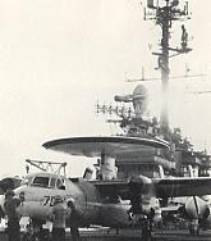 VAW-123 Hawkeye |
All these exercises, General Quarters Drill, Man Overboard, Chopsticks, Fire Drills, underway replenishment of ammunition along with our individual jobs are tempering the crew for the heavy workload of conducting Combat Air Operation on Yankee Station.
June 14, 1967
Forrestal's Operational Readiness Inspection began on 14 June 1967 in full swing. Plenty of air operations are being conducted all day in conjunction with a Air Defense Drill, General Quarters, Man Overboard Drill, Underway Refueling and Underway Rearming.
On 15 June 1967 as the Operational Readiness Inspection continues the crew of USS Forrestal has another busy day packed full of Flight Operations, Gunnery Exercise, General Quarters Drill, and Rearming.
June 16, 1967
On the morning of 16 June 1967 Forrestal returned to St. Thomas Harbor to disembark the observers from the USS Independence marking completion of her Operational Readiness Inspection.
Today, Forrestal completed her Operational Readiness Inspection receiving a grade of Excellent. Several hours later heaved in her anchor and got underway to cross the equator enroute to Rio de Janeiro, Brazil.
June 17, 1967
USS FORRESTAL FAMILY GRAM
Dear Forrestal Friends and Family
The day we have anticipated for many months has arrived! Long ago Navy planners scheduled Forrestal for this deployment with June 6th as the target date. Characteristically Forrestal begins her eleventh deployment right on schedule and ready for the great challenge, which lies before her.
Departures of our ships are necessarily somewhat sad. The next few months will have many lonely moments, but I hope that you will always remember that your man in Forrestal, by this absence, will be contributing to the freedom of the world. Since leaving the shipyard the men have worked hard and what was once a rather loosely knit group of sailors aboard a ship, has now become a team of men who are ready to enhance the proud record —unsurpassed in the Navy— that Forrestal has always borne.
There have been a number of occasions during our last at sea period for the men to exhibit their work before others not familiar with carrier life. One very distinguished person, Baron Louis Scheyven, the Belgian Ambassador to the United States spent three days aboard, and told me how impressed he was not only with the size and complexity of the ship, but by the men of Forrestal. The Ambassador is a lively man of 62 who delighted in everything he saw and asked to see more. Traditionally we cut a cake in honor of the Air Crew, which makes each 1000th landing aboard ship. Correspondingly, we found it most appropriate to cut a cake in honor of the active Ambassador on the occasion of his climbing the 1000th ladder during his visit.
The Ambassador witnessed another cake cutting, in honor of the aircraft, which made the 124,000th landing aboard Forrestal. We had been conducting evaluations tests on the Navy's new Automatic Carrier Landing System (ACLS), and although there was a pilot aboard the aircraft, the ACLS equipment flew the aircraft and made the landing automatically.
We also witnessed the first night automatic landing ever made on a Navy aircraft carrier. After the evaluators analyze the hundreds of pages of data they accumulated, they'll be able to determine where the minor "bugs" are and make the proper adjustments. There is good expectation that this system tested on Forrestal eventually will be installed in practically all carriers.
During that same at sea period we hosted over 30 visitors, ranging from the Ambassador to military representative of the Army and Air Force. They were all much impressed. The men in fact worked so hard during that cruise that we finished up our work ahead of schedule and returned to port Thursday afternoon, one day early. Then on Saturday, May 20th, we played host to our favorite VIP, you, the families, and friends of the men of Forrestal. For those of you who were unable to attend, I would like to describe the day's events:
Over 3,000 guests boarded Forrestal at 6:30 in the morning... and at 7 a. m., right on schedule, we left Pier 12... much to the dismay of about ten guest who arrived late and didn't make it aboard the ship. Four destroyers also held their Family Day cruises that Saturday and joined us for the occasion.
After clearing the channel, one of the destroyers came alongside Forrestal and we demonstrated a high-line transfer, utilizing Forrestal's most junior naval officer, Ensign John Elsheimer, for the demonstration. And then, a short time later, the aircraft of Carrier Air Wing 17 began an aerial firepower demonstration. The demonstration was spectacular, to say the least, as the planes flew in formation, dropped bombs, shot missiles, and exhibited in-flight refueling.
Unfortunately at this point, the guests of the destroyer sailors found the seas too rough and the destroyers had to return to port.
As the day continued, we divided our guests into groups and they observed landings and catapult takeoffs. The noise was loud, but even on the bridge we were able to hear the enthusiastic reaction of our guests as our planes roared in for their landings. While not watching air operations, our guests toured the ship, and had a close look at the display of aircraft in the hangar deck. The fine band of Commander Carrier Division Two provided music on the trip back to the pier. Many of Forrestalís friends that day also became "TV celebrities" through our closed circuit network, which had a camera and announcer on the hangar deck. The interviews we videotaped and will be played back to the crew during the deployment.
The numerous letters and cards I have received from many of our guests are indicative of the overall success of the Family Day cruise. In fact, so many have written that I am unable to answer each individual letter and ask that those who have written consider this Family gram as my response. Let me say, however, that the officers and men of Forrestal were pleased and proud to show their ship to you. Hopefully we'll be able to do it again next spring.
This past week has been quite busy as truckload after truckload of material has been loaded. Everyone has been continually checking to make sure that the proper types and quantities of supplies are aboard. In the final analysis, however, I can truthfully report that Forrestal is ready. The ship is in outstanding condition. And, most important, the men are ready. They know their jobs and their moral is high.
During the latter part of June and until mid-July, because of the distance involved, mail is not expected be leaving or coming aboard the ship. But keep writing and when last we do get the mail, your man will boastfully compare the number of letters he gets with those received by his friends. Mail is an important factor in a sailor's life. By the way, the proper address for men aboard Forrestal who are not members of a squadron is:
His name and rate
Division
USS FORRESTAL (CVA-59)
FPO, New York 09501
For men in a squadron, address your letters like this:
His name and rate
Squadron
FPO, New York 09501
My next letter to you will be in July. Until then, remember your man in Forrestal!
Sincerely yours,
J. K. Beling
Captain, U. S. Navy
Commanding Officer
June 18, 1967
Having completed her Operational Readiness Inspection and receiving a grade of excellent Forrestal steamed from St. Thomas from 17 June 1967 through 18 June 1967 enroute to the equator.
As Forrestal neared the realm of Neptunus Rex, 4,330 pollywogs, fearing for their well being, revolted and locked up 500 shellbacks aboard ship. A mild form of mayhem ensues for a number of hours as the pollywogs sought revenge prior to their initiation. At 2400 after stealing the shellback cards, the pollywogs hold a fake initiation on the flight deck. This revolt/ceremony lasted four hours.
What happens when you find a phony ten-dollar bill? You either try to pass it to someone else, or you turn it into the local bank so the Treasury Department can start looking for the counterfeiters.
What happens when 4,400 phony Shellback cards are distributed? You collect them and make the counterfeiters earn them, the hard way.
This is the case as Forrestal steams south toward Rio de Janeiro.
It began this afternoon. It is a quiet Sunday; not much action about the ship, now and then some salty Chief is carried out of the engine room, or a boatswain's mate is tied up with one of his knots. To most, these are isolated cases of Pollywogs having fun, getting in a little revenge before the upcoming initiation.
Soon these isolated cases are adding up, still not much to worry about.
About 2000 hours, however, it became evident that this was a full-blown rebellion, and the ship's complement of Shellbacks had suddenly disappeared.
The coup is a rousing success. How did this happen? Who was behind it? What was the purpose?
Elementary Sherlock. It was a devious plot to initiate the Pollywogs with as little effort as possible. It is still undetermined who the leader of the plot was, but there has been much speculation.
So, with their own Royal Court, a midnight spectacle was unfolded on the flight deck. Four hours later, Forrestal had a full crew of Shellbacks. Or had it?
June 19, 1967
On 19 June 1967 as Forrestal neared the equator the Plan of the day read:
| 0430 hours to 0600 hours | BREAKFAST FOR ALL POLLYWOGS IN THE GENERAL MESS. CAPTAIN BELING TO OPEN THE LINE. |
| 0600 hours | BREAKFAST FOR ALL SHELLBACKS (AFTER MESS DECK/CPO MESS/WARDROOM 2 and 3). |
| 0615 hours | POLLYWOGS RETURN TO THEIR BERTHING AREAS TO AWAIT FURTHER INSTRUCTIONS. |
| 0700 hours | INITIATION AS ANNOUNCED OVER THE 1MC. |
| Signed R. W. Kohler Royale Scribe. | |
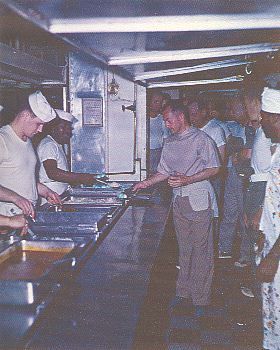 Captain Beling in Breakfast Chow Line |
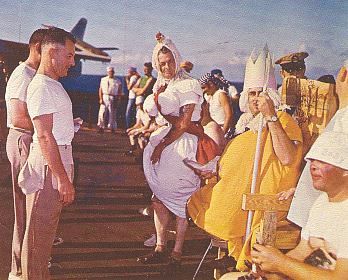 Captain Beling before the Shellback Court |
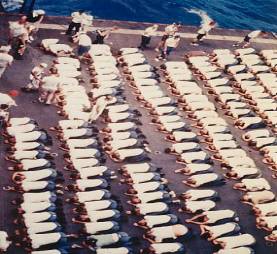 Pollywogs await their fate |
Generally while Pollywogs waited in their berthing compartments, a veteran Shellback arrived. He walks around the compartment asking questions and with a grease pencil; he places marks on the menís foreheads. Later the lowly Pollywogs were called away as division/squadron after division/squadron were instructed to report to the hangar bay one. After being told to walk onto elevator one they are told to kneel down for the quick ride above to the flight deck. Once at flight deck level they were told to get in line for the Royal Barber. Depending on how many marks the men had on their foreheads; corresponded to the amount of hair they were about to lose. The more marks, meant more of your hair would soon be on the deck. Approaching the Royal Barber, and after noting the marks on a sailors forehead, the Royal Barber commenced to cutting away each sailors hair with his electric shears.
By the elevator-full, the lowly Pollywogs are transported to the flight deck where the friendly Royal Family greeted them. After a short visit, or just plain passing the time of day, they too had their turn to really find out what an initiation should be like.
After getting their hair cut, the men formed lines to have our faces forced into the biggest, grease covered belly that the Shellbacks could come up with. The Shellbacks used short lengths of 2" wide nylon straps for spanking. The Pollywogs crawled on their hands and knees through a canvas tube about 40 feet long. The tube had garbage and salt water inside. Then on to a dunking in a lower half section of a jet engine container, which was filled with more garbage and who only knows what. The men can see lots of eggshells, garbage in the yellow water.
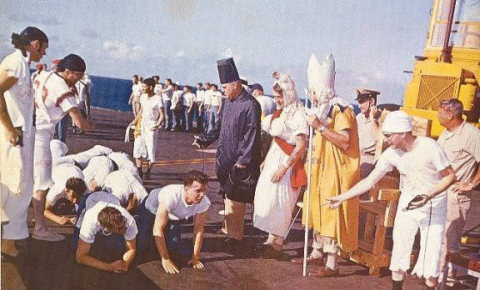 Pollywogs about to get a haircut |
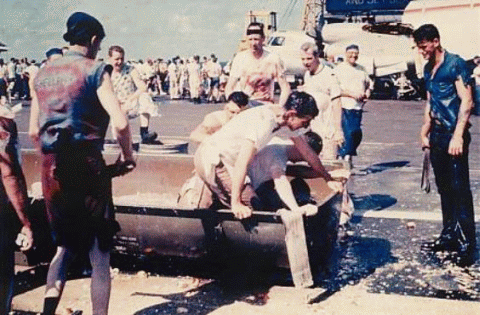 Donít Drink the Water |
The men received more spanking, during additional runs through gauntlets of nylon strap swinging Shellbacks. It was a good time. No one got hurt, so it was a good experience.
Many of the crew saw Captain Beling, the Executive Officer Captain J. W. Taft, and the future Executive Officer Commander Ralph F. Smith and their Marine Orderlies, all soak'en wet, clothes inside out and backwards, grease on their faces, just like the rest of the crew.
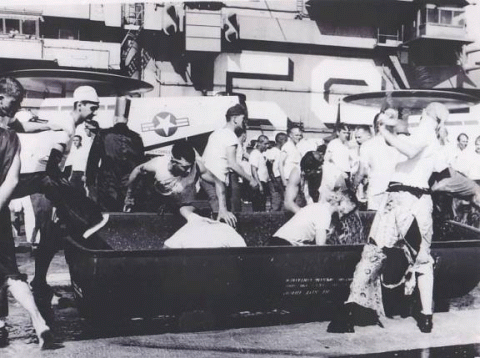 Few avoided being dunked |
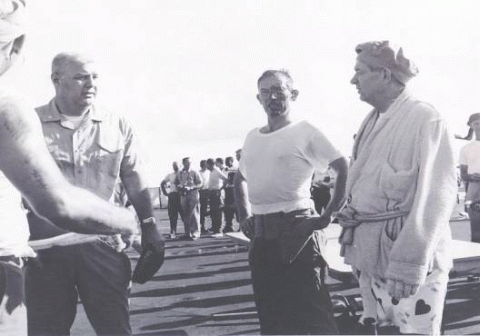 Shellback Commander Alfred Howard (left); Pollywog Captain John K. Beling (center); Unknown (right) |
At 1300 hours, Neptunus Rex and his Court took their leave of Forrestal, thoroughly convinced that every man aboard Forrestal was now a trusty subject, and that he could count on every man, from Captain Beling down to the newest Seaman Apprentice, to uphold his name and what it stands for.
On the afternoon of 19 June 1967 after the Shellback initiation concluded Forrestal steamed south enroute to Rio de Janeiro, Brazil.
June 22, 1967
On 22 June 1967 while enroute to Rio de Janeiro Forrestal launched its C-1A Trader aircraft to fly to Rio de Janeiro and pick up some Brazilian and American visitors and bring them onboard ship for an Air Wing Seventeen Air show. Admiral Rademaker, Minister of the Brazilian Navy, and Mr. John Tuthill, American Ambassador to Brazil will be among the many visitors.
June 23, 1967
Early in the morning of 23 June 1967 as Forrestal steamed toward Rio de Janeiro, Brazil she maneuvered while conducting flight Operations and air demonstration for Admiral Rademaker, Minister of the Brazilian Navy, Admiral Maia, Brazilian Chief of Naval Operations, and Mr. John W. Tuthill, American Ambassador to Brazil and more than their 35 distinguished guests. Over twenty-one aircraft participated in the Air Show. After the air demonstration concluded Forrestal anchored in Guanabara Bay.
 Corcovado Peak |
 USS Forrestal at anchorage, Rio de Janeiro, Brazil |
June 26, 1967
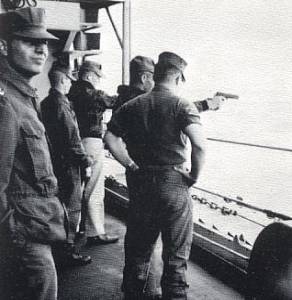 Marine Corps Small Arms Training |
While Forrestal steamed independently from Rio de Janeiro enroute to Subic Bay, in the Philippine Islands training continued. During the many days to follow until Forrestalís arrival at Subic Bay, the men of Forrestal and Air Wing Seventeen will continue training. Drills were held daily, such as, Man Overboard, Chopsticks Emergency, Collision, Fire, Abandon Ship, General Quarters, Steering Casualty, and Gunnery.
| Main Photo Index |
Aircraft Carrier Photo Index Page |
USS Forrestal (CVA-59 / CV-59 / AVT-59) Main Page |
Comments, Suggestions or Image submissions, E-mail Carrier Information
Problems and site related matters, E-mail Webmaster
This page was created and is maintained by Fabio Peña
![]()
Last update: 8 July 2007